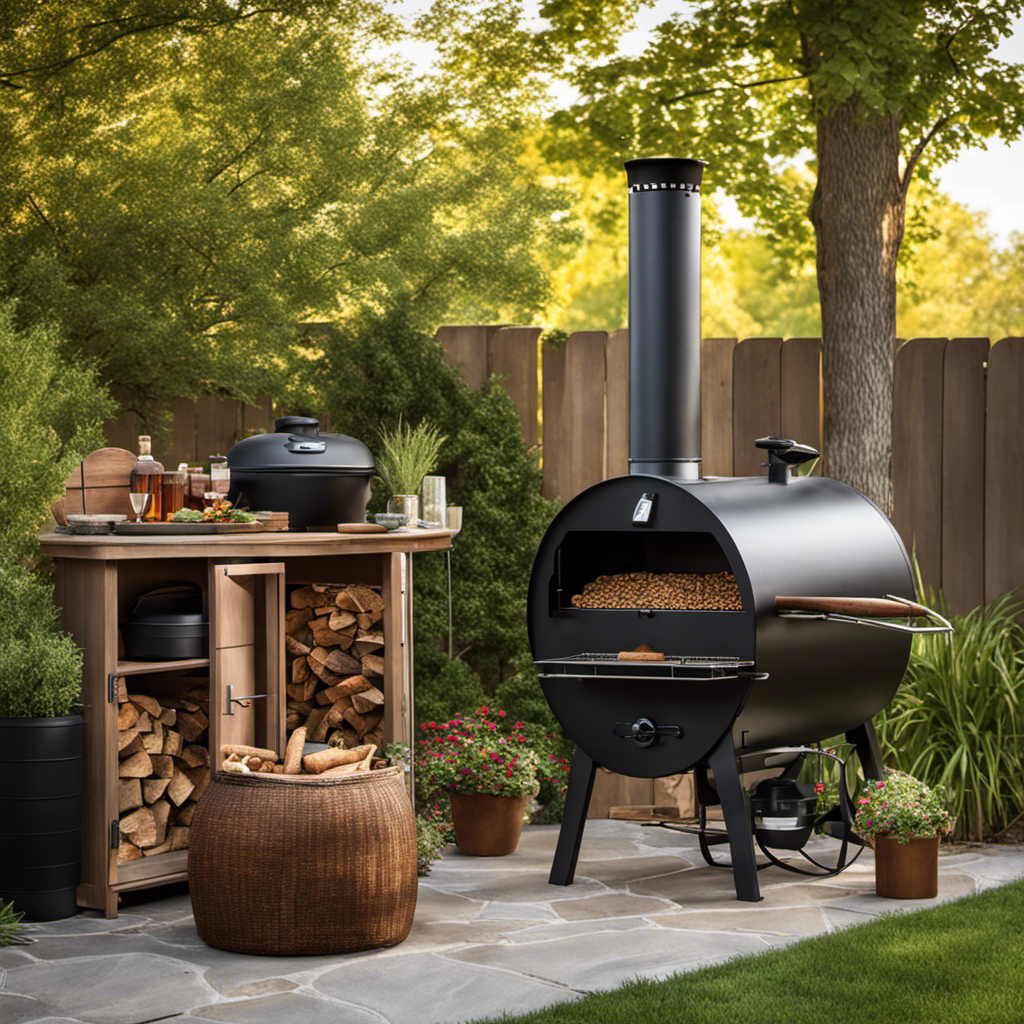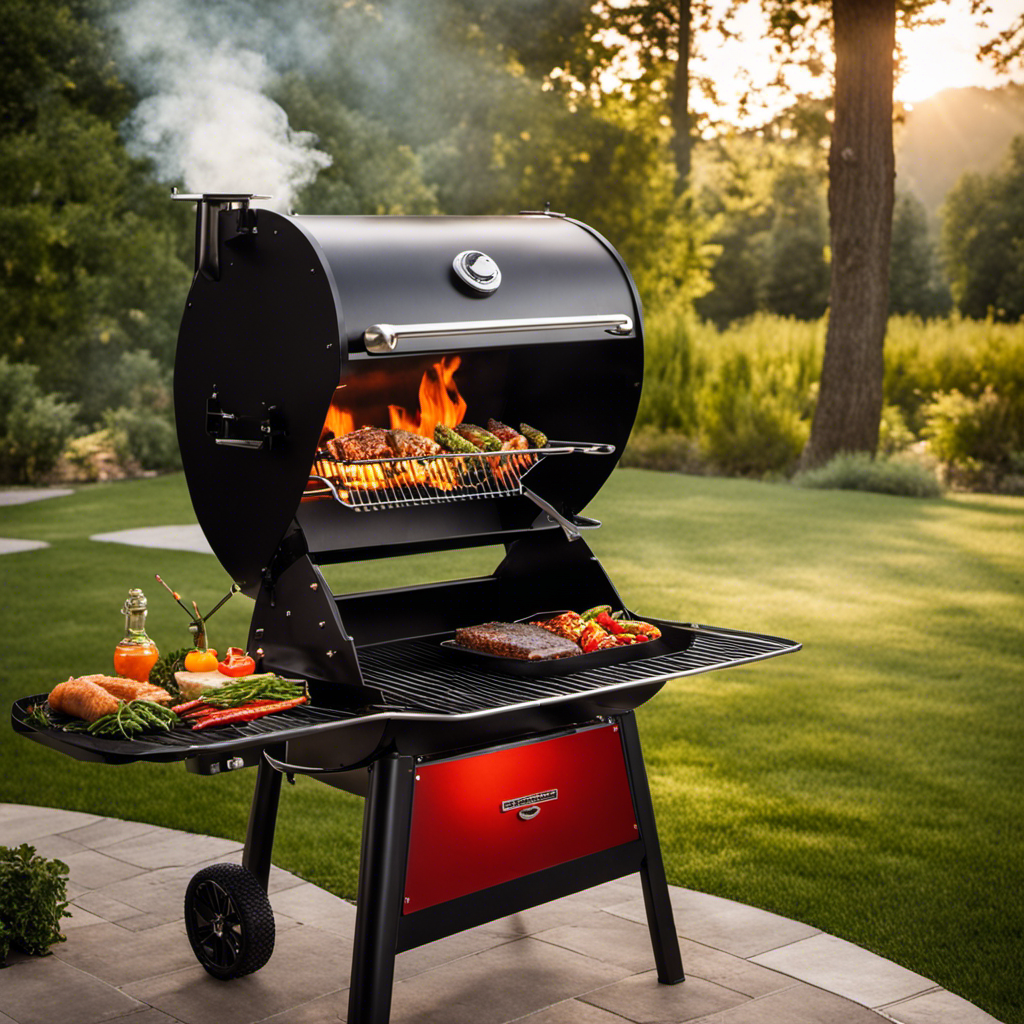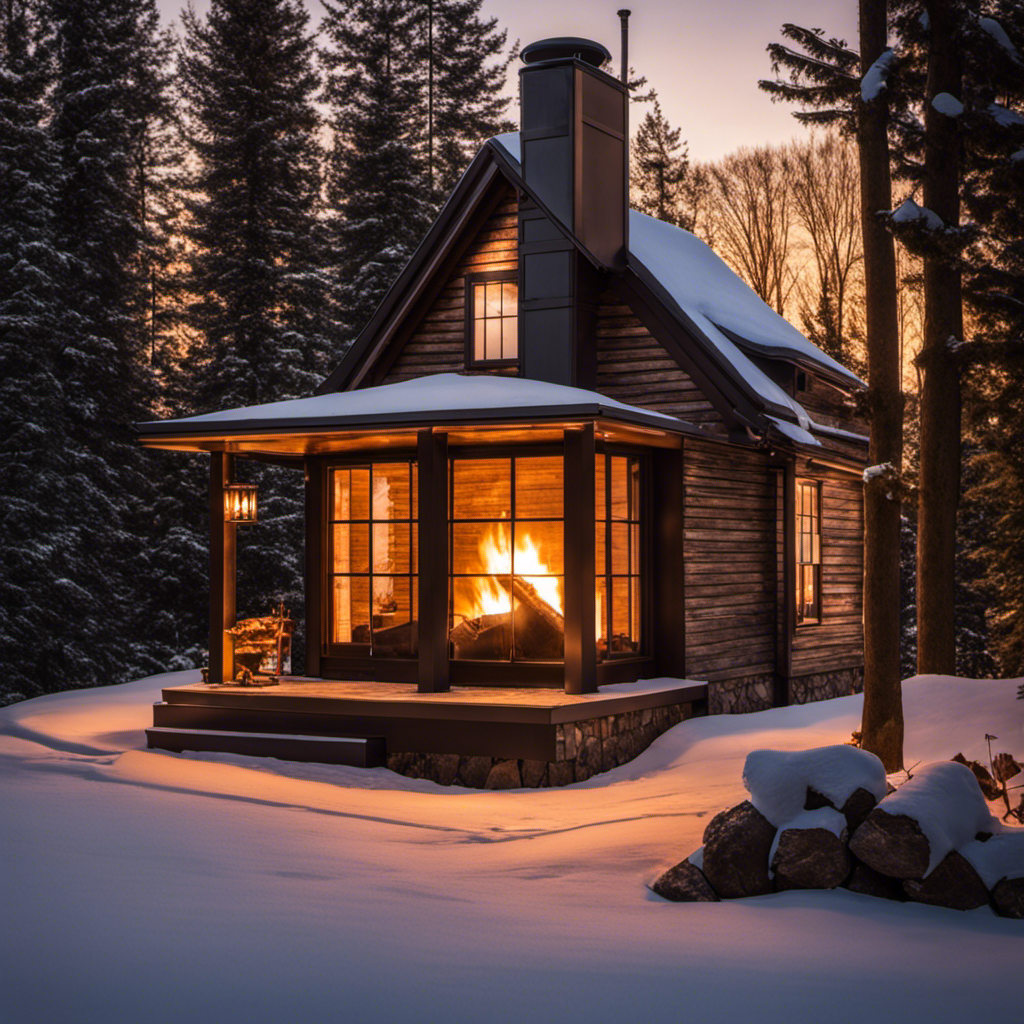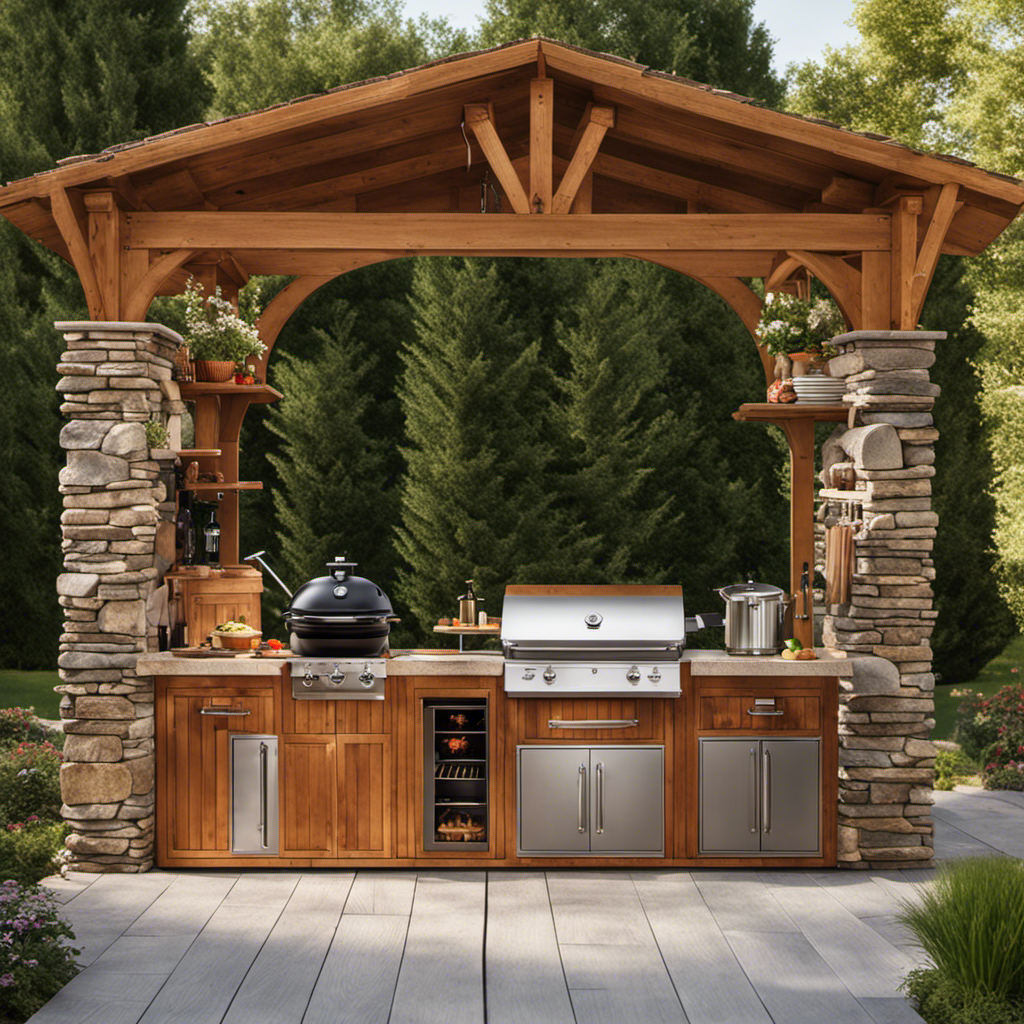As someone who owns property, I frequently catch myself pondering, ‘What is the most effective method to warm up my house?’ Considering the vast array of choices out there, it can seem daunting to settle on one.
Did you know that wood burning stoves have been used for centuries, while pellet stoves are a more recent invention? In this article, we will delve into the debate of wood burning versus pellet stoves, examining factors such as efficiency, environmental impact, cost, and more.
Let’s explore the pros and cons of each to help you make an informed choice for your home.
Key Takeaways
- Pellet stoves are more efficient and provide consistent heat output compared to wood burning stoves.
- Pellet stoves produce lower CO2 emissions and offer better indoor air quality.
- Pellet stoves have lower fuel costs and maintenance requirements, resulting in potential savings on heating bills.
- Pellets are more environmentally friendly and widely available compared to firewood.
Efficiency Comparison
Wood burning stoves are generally less efficient than pellet stoves. When it comes to heating efficiency, pellet stoves have the advantage. They are designed to burn pellets made from compressed wood or biomass, which provides a consistent and controlled heat output. This means that pellet stoves can reach higher levels of heating efficiency compared to wood burning stoves.
The heat output of pellet stoves can be adjusted and regulated, allowing for more precise temperature control. On the other hand, wood burning stoves rely on the combustion of logs or wood chips, which can vary in quality and moisture content. This can lead to lower heating efficiency and less consistent heat output.
Considering the differences in heating efficiency and heat output, it is important to also evaluate the environmental impact of both types of stoves.
Environmental Impact
If you’re concerned about the environmental impact, you might want to consider the emissions produced by both options. Wood burning stoves and pellet stoves have different carbon footprints and air quality impacts.
Here are three key points to consider:
-
Carbon Footprint: Wood burning stoves emit carbon dioxide (CO2), a greenhouse gas that contributes to climate change. Pellet stoves, on the other hand, produce lower CO2 emissions due to their higher combustion efficiency and use of renewable wood pellets.
-
Air Quality: Wood burning stoves can release pollutants such as particulate matter, nitrogen oxides, and volatile organic compounds, which can negatively affect air quality and human health. Pellet stoves, with their advanced combustion technology and cleaner fuel, produce fewer pollutants and offer better indoor air quality.
-
Environmental Regulations: Some areas have strict regulations on wood burning due to its impact on air quality. Pellet stoves, being cleaner and more efficient, may be favored in such regions.
Considering these factors, it’s important to evaluate the environmental impact of both options before making a decision.
Moving on to the cost analysis…
Cost Analysis
When it comes to cost analysis, you’ll want to consider factors such as fuel prices, maintenance expenses, and potential savings on heating bills. In terms of fuel efficiency, pellet stoves tend to be more efficient than wood burning stoves. They can burn pellets at a consistent rate, resulting in less wasted fuel and higher heating efficiency. Additionally, pellets are often made from waste materials, making them a more cost-effective and environmentally friendly fuel option. To further illustrate the cost analysis, here is a comparison table:
| Factor | Wood Burning Stove | Pellet Stove |
|---|---|---|
| Fuel Efficiency | Moderate | High |
| Fuel Cost | Low | Moderate |
| Maintenance | Moderate | Low |
| Heating Savings | Moderate | High |
| Long Term Cost | High | Moderate |
Considering the long term cost analysis, pellet stoves prove to be a more economical choice due to their higher fuel efficiency and potential savings on heating bills. Now let’s delve into the next section about ‘heating capacity’.
Heating Capacity
To determine the heating capacity of your stove, you’ll need to consider factors such as the size of the room you want to heat, insulation levels, and the stove’s BTU rating.
The heating efficiency of a stove refers to how effectively it converts fuel into heat. Wood burning stoves tend to have lower heating efficiencies compared to pellet stoves. This means that wood burning stoves may consume more fuel to generate the same amount of heat as a pellet stove.
However, the size and insulation of the room also play a significant role in determining the heating capacity. A well-insulated room will retain heat better, allowing for a smaller stove to effectively heat the space.
When considering heating capacity, it is important to balance heating efficiency and fuel consumption with the specific needs of your room.
Transitioning to the next section, let’s now explore the maintenance requirements of wood burning and pellet stoves.
Maintenance Requirements
When it comes to maintenance requirements, there are several key points to consider.
First, it’s important to compare the cleaning frequency between different heating systems.
Second, the cost of maintenance should be taken into account, as this can vary greatly depending on the type of system.
Finally, it’s crucial to understand the common maintenance issues that may arise with each type of heating system.
Cleaning Frequency Comparison
The cleaning frequency for wood burning stoves is typically higher than that for pellet stoves. This is due to the difference in the combustion process and the type of fuel used. Wood burning stoves produce more ash and creosote buildup, requiring regular cleaning to maintain efficiency and safety. On the other hand, pellet stoves burn compressed wood pellets, which produce less ash and require less frequent cleaning. To illustrate the difference in cleaning frequency, here is a comparison table:
| Cleaning Technique | Wood Burning Stoves | Pellet Stoves |
|---|---|---|
| Ash Removal | Weekly | Monthly |
| Creosote Cleaning | Monthly | Not Required |
| Chimney Sweeping | Annually | Not Required |
As you can see, wood burning stoves need more frequent cleaning, including ash removal, creosote cleaning, and chimney sweeping. This maintenance schedule is necessary to prevent fire hazards and ensure optimal performance. Moving forward, let’s discuss the cost of maintenance for wood burning and pellet stoves.
Cost of Maintenance
The cost of maintaining wood burning and pellet stoves can vary depending on factors such as fuel prices and the need for professional servicing. Here are four key factors to consider when calculating the cost of maintenance for these types of stoves:
-
Fuel Prices: The cost of wood or pellets can fluctuate based on supply and demand, so it’s important to factor in the ongoing expenses of purchasing fuel for your stove.
-
Efficiency: Wood burning stoves tend to be less efficient than pellet stoves, which means they may require more fuel to produce the same amount of heat. This can increase the overall cost of maintenance for wood burning stoves.
-
Repairs: Both wood burning and pellet stoves may require occasional repairs, such as replacing parts or fixing ventilation issues. These repair costs should be taken into account when considering the long-term maintenance expenses.
-
Professional Servicing: Regular maintenance and cleaning by a professional technician can help ensure the optimal performance of your stove. However, these services can add to the cost of maintaining your stove.
Considering these factors will help you estimate the total cost of maintaining a wood burning or pellet stove. Now, let’s explore some common maintenance issues that may arise with these types of stoves.
Common Maintenance Issues
In terms of maintenance, both wood burning and pellet stoves require regular care to ensure optimal performance. However, there are some common maintenance issues that may arise with these stoves.
One important tip for wood burning stoves is to regularly clean the chimney to prevent the build-up of creosote, which can pose a fire hazard. For pellet stoves, it is essential to clean the hopper and the burn pot regularly to prevent clogs and ensure proper fuel combustion.
Additionally, troubleshooting guide for both types of stoves includes checking for proper ventilation, inspecting the gaskets for any leaks, and ensuring that the fans and blowers are functioning correctly.
By following these maintenance tips and troubleshooting guide, you can keep your wood burning or pellet stove in good condition and enjoy its efficient heating capabilities.
When it comes to fuel availability…
Fuel Availability
Wood burning stoves require a steady supply of firewood. Pellet stoves, on the other hand, rely on pellets made from compacted sawdust. When considering fuel availability for these stoves, it is important to take into account fuel sustainability and carbon emissions.
Here are some key points to consider:
- Firewood is a renewable resource, but it requires proper sourcing and management to ensure sustainability.
- Pellets are made from sawdust, a byproduct of wood processing, making them a more environmentally friendly option.
- Using firewood can contribute to carbon emissions, especially if it is not properly dried and burned efficiently.
- Pellets have lower carbon emissions due to their higher energy density and uniform composition.
- Availability of firewood depends on local resources, while pellets are widely available and can be purchased in bulk.
Considering the sustainability and environmental impact, pellet stoves offer a more efficient and eco-friendly option compared to wood burning stoves.
Now, let’s move on to the installation considerations.
Installation Considerations
When considering the installation of a stove, there are several key points to take into account.
First, ventilation requirements must be carefully considered to ensure proper air circulation and prevent any potential hazards.
Second, it is important to be aware of safety regulations to ensure compliance with local codes and standards.
Lastly, the cost and availability of fuel should also be taken into consideration to determine the most practical and efficient option for your needs.
Ventilation Requirements
Although pellet stoves have lower ventilation requirements, they still require proper installation. Ventilation design plays a crucial role in ensuring indoor air quality when using a pellet stove.
Proper ventilation allows for the removal of harmful combustion byproducts, such as carbon monoxide, and helps maintain a healthy environment inside the home. When installing a pellet stove, it is important to consider the location of the stove in relation to windows, doors, and other openings to ensure adequate air circulation.
Additionally, proper venting systems must be installed to safely exhaust the combustion gases outside. Neglecting to address ventilation design can lead to poor indoor air quality and potential health hazards. Therefore, it is essential to follow proper installation guidelines to guarantee the safe and efficient operation of pellet stoves.
Compliance with safety regulations ensures the well-being of both the occupants and the environment.
Safety Regulations
Proper installation guidelines must be followed to ensure the safe and efficient operation of pellet stoves, as well as compliance with safety regulations. When it comes to regulatory compliance and fire hazards, here are three important considerations:
-
Clearances: Pellet stoves require specific clearances from combustible materials, such as walls and furniture. Following these clearances is crucial to prevent fire hazards and maintain regulatory compliance.
-
Ventilation: Proper ventilation is essential for pellet stoves to operate safely and efficiently. Adequate air supply and proper exhaust system installation are necessary to avoid carbon monoxide buildup and ensure compliance with safety regulations.
-
Electrical Connections: Pellet stoves require electrical connections for ignition and operation. It’s important to follow the manufacturer’s instructions and ensure proper wiring to avoid electrical hazards and comply with safety standards.
Ensuring regulatory compliance and addressing fire hazards is vital when installing pellet stoves.
Now let’s explore the next section on cost and fuel availability.
Cost and Fuel Availability
The cost of fuel and its availability are important factors to consider when deciding on a heating option. Wood burning stoves are often seen as a more affordable choice since firewood is readily available and can be sourced locally.
However, it is essential to consider the fuel efficiency of wood burning stoves, as they can consume a larger amount of wood compared to pellet stoves. Pellet stoves, on the other hand, utilize pellets made from compressed sawdust or wood chips, which are highly efficient in burning and provide a consistent heat output. Additionally, pellet stoves are considered more environmentally sustainable due to their lower emissions and use of renewable resources.
Transitioning to the next section, safety features are another crucial aspect to consider when choosing between wood burning and pellet stoves.
Safety Features
One advantage of pellet stoves is that they have built-in safety features. These features are designed to enhance fire prevention and carbon monoxide detection, making pellet stoves a safer option for heating your home compared to traditional wood-burning stoves. Some common safety features found in pellet stoves include:
| Safety Features | Description |
|---|---|
| Automatic Shutdown | Pellet stoves are equipped with sensors that detect unsafe conditions, such as high temperatures or low oxygen levels, and automatically shut down the stove to prevent accidents. |
| Fireproof Glass | The viewing window on pellet stoves is made of fireproof glass, allowing you to enjoy the warmth and ambiance of the fire without the risk of sparks or embers escaping. |
| Carbon Monoxide Detector | Pellet stoves often come with integrated carbon monoxide detectors that will alert you if dangerous levels of this odorless gas are detected. |
These safety features not only provide peace of mind but also ensure the well-being of you and your family. Transitioning to the next section, let’s now explore the aesthetics of pellet stoves.
Aesthetics
To enhance the ambiance of your home, consider the aesthetics of pellet stoves. They offer a modern and stylish look that can complement any interior design. With their clean lines and compact size, they can easily fit into any space, whether it’s a traditional or contemporary setting.
Pellet stoves also come in a range of colors and finishes, allowing you to choose the one that best matches your decor. Beyond their visual appeal, they excel in heat distribution. They utilize a fan system to evenly distribute warm air throughout the room, ensuring a comfortable and cozy environment.
This efficient heat distribution system makes pellet stoves a practical and attractive choice for heating your home.
Frequently Asked Questions
How Do Wood Burning and Pellet Stoves Compare in Terms of Their Impact on Indoor Air Quality?
In terms of their impact on indoor air quality, wood burning and pellet stoves can differ. The comparison of emissions and their effect on respiratory health is important to consider when choosing between the two.
Are There Any Specific Regulations or Restrictions on the Use of Wood Burning or Pellet Stoves in Certain Areas?
In terms of specific regulations and restrictions, it’s important to consider the use of wood burning and pellet stoves. Factors like emissions, permits, and designated areas can impact their usage and installation.
Can Wood Burning or Pellet Stoves Be Used as the Primary Source of Heating for an Entire Home?
As the primary source of heating for an entire home, wood burning and pellet stoves can be cost-efficient and have varying environmental impacts. However, it is important to consider factors such as availability, maintenance, and local regulations.
What Are the Main Factors to Consider When Deciding Between a Wood Burning or Pellet Stove in Terms of Installation Requirements?
When deciding between a wood burning or pellet stove, it’s important to consider the installation requirements and cost comparison. These factors can help determine which option is more suitable for your home and heating needs.
Are There Any Health Risks Associated With Using Wood Burning or Pellet Stoves, Such as Exposure to Carbon Monoxide or Other Harmful Emissions?
Using wood burning or pellet stoves can pose health risks due to potential exposure to carbon monoxide and harmful emissions. It’s important to compare the impact on indoor air quality before deciding which is better.
Is a Pellet Stove a Better Option Than a Wood Burning Stove for a Gas Fireplace?
When considering a gas fireplace, a pellet stove may be the best option. Unlike a wood burning stove, a pellet stove burns cleaner and with less maintenance. The convenience of the best gas, pellet fireplace makes it a better choice for those looking for efficient and hassle-free heating.
Conclusion
After analyzing the efficiency, environmental impact, cost, heating capacity, maintenance requirements, fuel availability, installation considerations, safety features, and aesthetics of wood burning and pellet stoves, it is evident that both options have their own advantages and disadvantages.
However, one cannot deny that wood burning stoves provide a warm and cozy atmosphere akin to a crackling fireplace on a winter evening.
Like a comforting hug from an old friend, the wood burning stove brings a sense of nostalgia and comfort to any home.











